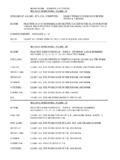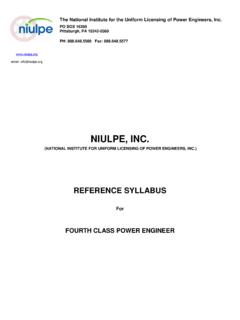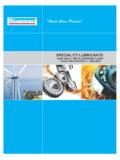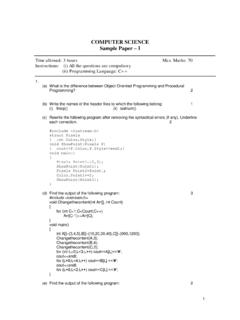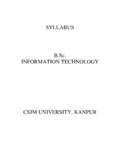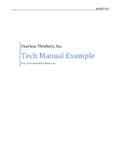Transcription of EXTINGUISHER - Jamaica Fire Brigade | "Saving …
1 EXTINGUISHER . INTRODUCTION. Fire extinguishers are essential fire suppression tools that firefighters us in the initial stage of a fire and against this background, it is important to be knowledgeable of the innumerable types and be able to determine the most suitable type for different situations. It is ideally important to be familiar with the various parts and their functions. Primarily, fires generally start small and with the proper know-how and application, an EXTINGUISHER can be used to prevent what could be a major conflagration. Extinguishers also prevent water and other damages which may occur in fighting small fires. Aim Of Module The purpose of this module is to sensitize firefighters on the subject of extinguishers. Module Objectives On completion of this module trainees will be able to: state what is an EXTINGUISHER describe how the extinguishing media in EXTINGUISHER are expelled state the different types of extinguishers explain the advantages and disadvantages of the different extinguishing media outline and describe the production of foam in extinguishers list the different types of vaporizing liquids list the chemicals used in dry chemical powder extinguishers name the principal parts of an EXTINGUISHER identify the principal parts of an EXTINGUISHER recommend the ideal extinguishers for the different types of fire explain the operation of a fire EXTINGUISHER demonstrate the use of a typical fire EXTINGUISHER 1.
2 EXTINGUISHERS. A fire EXTINGUISHER is a portable metal storage container for extinguishing agents such as water, dry chemical powder, foam etc. They are labeled A, B or C to the classification of the fires they are designed to be used on and are particularly effective in the incipient (early) stage of a fire. The extinguishing agent is expelled either by: a. CHEMICAL REACTION - pressure provided by a chemical reaction occurring. b. GAS CARTRIDGE - pressure provided by the piercing of an inert gas cartridge c STORED PRESSURE - pressure is stored in the EXTINGUISHER Each EXTINGUISHER will the following marked on it: i. the words Fire EXTINGUISHER . ii. method of operation iii. description of contents iv. year of manufacture v. testing pressure and working pressure vi. the standard based on certification by an accredited organization eg.
3 Bureau of Standards vii. the type (gas cartridge, stored pressure or chemical reaction). viii. the temperature range over which the EXTINGUISHER will operate satisfactorily ix. whether the EXTINGUISHER is to be recharged or discarded after use. Fire extinguishers may be classified by contents and by method of operation as shown in table (i). Table (i). CONTENTS. Water Foam Powder Halon Co2. Method of Chemical * *. Operation Gas cartridge * * *. Stored pressure * * * * *. 2. WATER (STORED PRESSURE) EXTINGUISHER . It consists of welded body that is plastic lined to prevent corrosion (as pressure tends to speed up corrosion) and has a screwed cap containing the valve assembly. It is filled with water and then pressurized by compressed air to 4 10. bars. The pressure is identified by means of a gauge.
4 The method of operation usually follows the basic procedure illustrated. 3. WATER (GAS CARTRIDGE) EXTINGUISER. Water is contained in a steel container, lined to prevent corrosion. The head cap assembly incorporates a plunger device and connection for 57g CO2 cartridge. The cartridge allows the CO2 to pressure the EXTINGUISHER and force the water through the discharge tube: Advantages: i. Often quickest for first attack ii. Requires only one person to operate it iii. Self contained iv. Reliable v. Instantaneous Disadvantages: i. Conductor of electricity ii. Not ideal for inaccessible fires 4. CHEMICAL FOAM EXTINGUISHER . Chemical foam extinguishers consist of an inner container within an outer EXTINGUISHER body. When the contents of the two are mixed together, a chemical reaction occurs producing foam and carbon dioxide CO2.
5 The CO2 fills the bubbles and also acts as an expellant. Contents: Outer container - Sodium Bicarbonate Solution Stabilizer - Saponin, Liquorices, Turkey-red oil Inner container - Aluminum Sulphate Solution More modern types containing self-aspiration foam have largely replaced these. 5. MECHANICAL FOAM EXTINGUISHERS. Foam concentrate is contained in solution in the EXTINGUISHER body. When expelled, the foam is aerated by means of a small foam-making branch at the end of the EXTINGUISHER hose. The foam is expelled by a gas cartridge or stored pressure. Advantages: These are similar to water-type EXTINGUISHER i. Coats surface and exclude oxygen ii. Heat resisting qualities acts as insulator, preventing re-ignition iii. Not affected by draughts iv. Floats on liquids Disadvantages: i. Some fires require alcohol resistant foam ii.
6 Some foam reacts with dry chemical and are broken down iii. Chemical and mechanical foam have harmful effects on each other (do not use together). When using foam, it should not be allowed to strike the surface of the burning material directly, but should be allowed to strike a vertical wall or side of the container so that it may run down and form a blanket which will spread over the liquid. If the liquid is not confined, allow the foam to fall gently over the surface of the liquid. 6. VAPORIZING LIQUIDS. EXTINGUISHER may also contain substances called vaporizing liquids. These are Halogenated Hydro Carbons (Halons). The more common types are: i. Bromochlorodiflouromethane (BCF). ii. Bromothriflouromethane (BTM). iii. Chlorobromomethane (CBM). These extinguishers are generally stored pressure types using CO2 or nitrogen as pressure agents.
7 This extinguishing medium has an inhibitory factor . This is the proportion of extinguishing medium which is required to be resent in air in order to prevent combustion. Because of their negatives impact on the environment, these extinguishers are being phased out. 7. DRY POWDER EXTINGUISHER . Various chemicals are used in dry powder extinguishers, depending on the job they are intended. For example: Sodium Bicarbonate - for flammable liquids (class B). Potassium Bicarbonate - used in the USA for class B fires Ammonium Phosphates - General Purpose for class A & B fires Ternary Eutectic Chloride - (TEC) for Uranium, Plutonium and Magnesium Alloys All dry powders are treated to improve their flow properties and reduce caking . This treatment may be involve the adding of a small portion of very fine silica to the contents.
8 8. CARBON DIOXIDE EXTINGUISHERS. These consist basically of a pressure cylinder with a valve for releasing the gas and a discharge horn. The gas is maintained in liquid form at a pressure of 50. bars (750 psi). The discharge horn allows the gas to expand at a ratio of 450:1. and when it is directed into the fire, prevents air from being pulled along entrainment by reducing the velocity of gas. The average discharge time is 16 . 30 seconds. Points to note: The gas makes considerable noise, this however indicates that the EXTINGUISHER is working. CO2 forms a dense vapor that may impair visibility in a confined space. CO2 has not cooling effect so there is risk of re-ignition. If the orifice at the sealing disc freezes, preventing discharge of the gas, it may be cleared in most models by closing and opening the control valve.
9 Advantages: i. Rapid in action, independent of atmospheric temperature. ii. It is an inert gas which quickly disperses, leaving no trace. iii. It is a non-conductor of electricity. iv. Can be used in the incipient (first) stage of highly flammable liquid fires. v. Penetrates inaccessible places Disadvantages: i. The total weight in relation to the contents is considerable ii. There is no visible way to check the contents Testing is usually in accordance with the manufacturer's instruction and at the times specified. In addition to these hand-held extinguishers, there are also what is known as trolley units and fixed installations. 9. 10. 11. WET CHEMICAL (K CLASS) EXTINGUSIHERS. Due to new and improved cooking appliances, higher heating rates and industry trends toward using more unsaturated oils, the potential for severe restaurant fires is greater than ever.
10 A new K Class EXTINGUISHER rated to specifically identify and address these commercial combustible cooking media fire hazard in the kitchen is developed. It contains a special Potassium Acetate based, Potassium Carbonate base or Potassium Citrate base with water. This EXTINGUISHER extinguishes the fires by removing the heat of the fire triangle and prevents re-ignition by creating a barrier between the oxygen and fuel elements. Wet chemical or Class K EXTINGUISHER developed for modern, high efficiency deep fat fryers in commercial cooking operations may also be used on Class A . fires (involving wood, paper, cloth, trash etc.) in commercial kitchen. This EXTINGUISHER can be obtained under different brand names. METAL / SAND EXTINGUISHERS. These extinguishers are for flammable metals (class D fires) and work by simply smothering the fire with powered copper metal or sodium chloride (NaCl).

